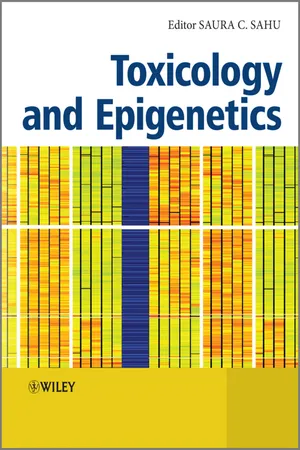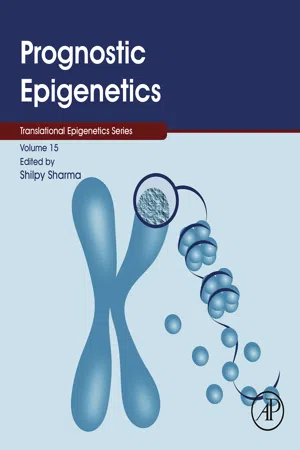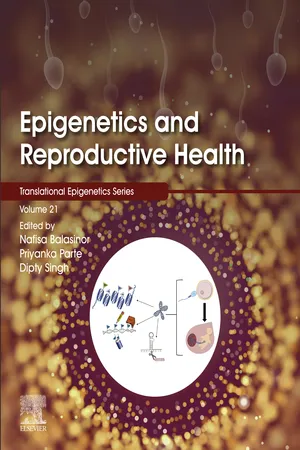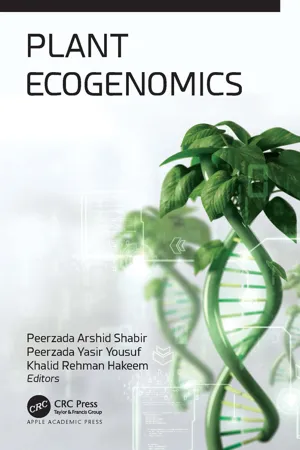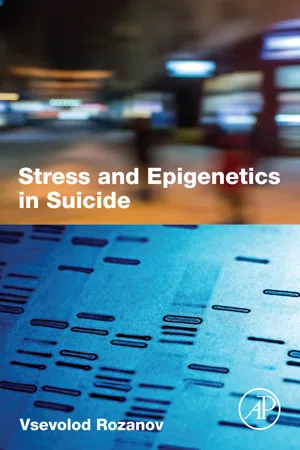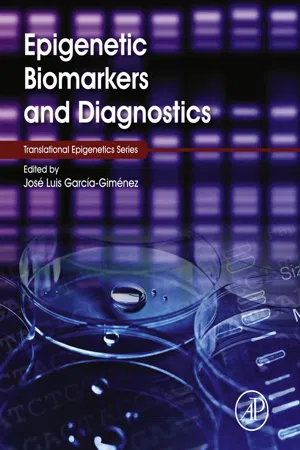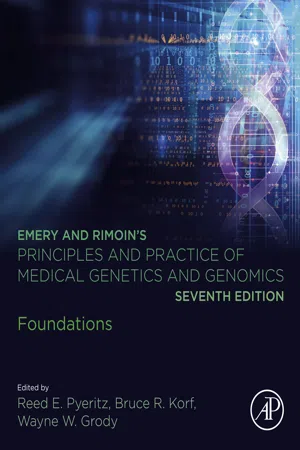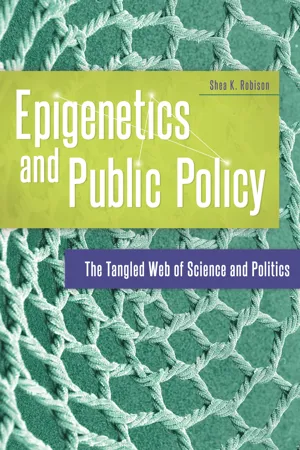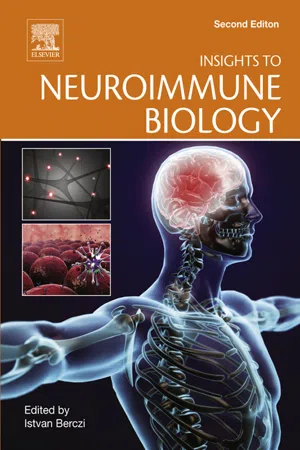Biological Sciences
Epigenetic Changes
Epigenetic changes refer to alterations in gene expression that do not involve changes to the underlying DNA sequence. These changes can be influenced by environmental factors and can have a significant impact on an organism's development and health. Examples of epigenetic changes include DNA methylation, histone modification, and non-coding RNA regulation.
Written by Perlego with AI-assistance
Related key terms
Related key terms
1 of 4
Related key terms
1 of 3
12 Key excerpts on "Epigenetic Changes"
- eBook - ePub
- Saura C. Sahu, Saura C. Sahu(Authors)
- 2012(Publication Date)
- Wiley(Publisher)
Historically, the term ‘epigenetics’ had a narrower definition in developmental biology and was not frequently used to describe developmental changes. The term ‘epigenetics’ was coined by Conrad Hal Waddington, incorporating the concept of ‘epigenesis’ (undifferentiated cells increase in complexity as development progresses) with ‘genetics,’ to describe the complex genetic and biological programs that unravel during embryonic development (Waddington, 1956). These programs, based on (i) the underlying genetic information and (ii) intercellular and intracellular communication, cause cells to differentiate into determinate tissues and organs, and eventually result in a complex living organism. Robin Holliday broadened the definition of epigenetics to describe DNA methylation changes that are inherited through cellular division and passed along to the next generation through germline cells (Holliday, 1987). In 1975, two studies (Holliday and Pugh, 1975; Riggs, 1975) independently described DNA methylation and its probable importance in differentiation, regulation, imprinting, and development. Since then, many more mechanisms of DNA modification and control of gene expression have been discovered. The other well-known Epigenetic Changes encompass gene expression and phenotypic changes brought about by histone modifications and small non-coding RNA molecules. Other novel mechanisms continue to be discovered.5.2 Mechanisms of molecular Epigenetic Changes
Three types of known molecular Epigenetic Changes include DNA methylation, histone modifications, and small non-coding RNAs that regulate gene expression (Figure 5.1 ). Prions also induce Epigenetic Changes in the genome, but are not discussed in this chapter. Novel discoveries of alternative mechanisms of epigenetic modifications continue to be made (Ooi and Bestor, 2008; Tahiliani et al., 2009; He, 2010).Figure 5.1 - eBook - ePub
- (Author)
- 2019(Publication Date)
- Academic Press(Publisher)
Chapter 1Basics of epigenetics: It is more than simple changes in sequence that govern gene expression
Shilpy Sharma; Osama Aazmi Department of Biotechnology, Savitribai Phule Pune University (Formerly University of Pune), Pune, IndiaAbstract
It is a widely accepted fact that distinction between species is defined not only by the ensemble of its genes but also more critically by how these genes are regulated such that the expression profiles change over space and time. Two major factors that determine gene expression and, in fact, a particular state of a functional cell, include genetics, the study of heritable changes in the nucleotide sequences, and epigenetics, the study of mitotically and/or meiotically heritable alterations in gene expression that are not associated with changes in the underlying DNA sequences. Here, we provide an overview about the major epigenetic mechanisms including DNA methylation, histone posttranslational modifications, chromatin modifications, and noncoding RNAs (including miRNAs and lncRNAs) that govern changes in gene expression that are actually dependent on the environment and not on the underlying gene sequence. These mechanisms are potentially reversible and play crucial roles in regulating normal growth and differentiation. Alteration in the epigenetic marks have often been linked with different disease processes; and several attempts have been made to use these epigenetic modifications as a biomarker for the identification of individuals at risk and/or suffering from a disease condition using minimally invasive techniques. Additionally, the reversible nature of these epigenetic marks offers an attractive target for therapy, and hence, several drugs that target epigenetic factors and/or the linked pathways are currently being developed and/or tested in clinical trials. These topics have been extensively discussed through the length of this chapter. - eBook - ePub
- Trygve Tollefsbol(Author)
- 2020(Publication Date)
- Academic Press(Publisher)
Epigenetic modifications are considered to be the genome wide changes that lead to the variation of expression of genes without altering the sequence of gene and more easily it can be described as a change in the phenotype rather than the genotype [ 1 ]. These changes can have different effects on the body ranging from the normal functioning or malfunctioning of the cells leading to fatal diseases, i.e. cancer. The variability of the epigenetic effects can be related to the specific functions of the genes. There are several mechanisms controlling the Epigenetic Changes in the genome but the most important and well-studied ones are DNA methylation, histone modification and genomic imprinting [ 2 ]. Methylation of DNA occurs by the methyl group addition usually at the 5’ cytosine. Promoter regions of CpG islands of the DNA sequence show the highest affinity toward the methyl group. Furthermore, there has been evidence of methylation in non-CpG islands, mostly in CpA segments [ 1 ]. The importance and effect of this type of methylation are not fully yet understood and it is believed that this kinds of methylation mostly occur in regions such as the brain, embryonic stem cells and oocytes. Besides CpG island methylation, histones, which belong to the family of alkaline proteins mostly found in the eukaryotes and have the function of packaging the DNA strand and making a complex known as the nucleosome, go through modifications of methylation, acetylation, and phosphorylation [ 3 ]. Methylation generally has a silencing effect on the transcription and gene expression. A number of enzymes, DNA methyltransferases such as DNMT1, are necessary for the process that functions in the maintenance of the methylation after DNA replication [ 4 ]. DNA methylation has been proven to have crucial role during gametogenesis and prenatal development [ 5 ]. In the last decade, studies have shown that gene expression is also affected by non-coding RNAs (ncRNAs) - eBook - ePub
- Peerzada Arshid Shabir, Peerzada Yasir Yousuf, Khalid Rehman Hakeem, Peerzada Arshid Shabir, Peerzada Yasir Yousuf, Khalid Rehman Hakeem(Authors)
- 2022(Publication Date)
- Apple Academic Press(Publisher)
Jablonka and Lamb, 2002 ).Recently, epigenetics has been defined as the “study of heritable changes in the expression of gene and function that are unexplainable by differences in the sequence of DNA” (Richards 2006 ; Bird 2007 ). Such epigenetic modifications can turn on, bring down, or inhibit the function of particular genes:- Cytosine methylation of DNA
- Alteration of DNA packing via; chemical modification (addition of methyl or acetyl group) of histone proteins and
- Mediation of regulatory processes by sRNA (small RNA) molecules.
These processes are dependent on each other and control gene function in an interactive, complex fashion (Berger, 2007 ).Among the different epigenetic mechanisms which alter gene expression, in ecological epigenetics most-common mechanism studied is methylation of cytosines in DNA (incorporation of a methyl group to CpG islands) (Schrey et al., 2013 ). Methylation of these sites often results in decreased activity of the associated gene and some methyltransferase enzymes catalyze this process. There are enough pieces of evidence that Epigenetic Changes can transfer to future generations as in toadflax, Arabidopsis thaliana, and mice (Richards 2006 ; Blewitt et al., 2006 ; Vaughn et al., 2007 ; Bock 2012 ). Methyltransferase enzyme affects the transgenerational inheritance of DNA methylation in plants, which replicates patterns of methylation during both meiosis and mitosis (Takeda and Paszkowski, 2006 ).A recent epigenetic study shows that natural variation in epigenetic modifications can be autonomous from DNA variation. For example, in Arabidopsis thaliana, large and consistent ecotypic variation in methylation of DNA has been found that was not associated with genetic variation (Cervera et al., 2002 ; Vaughn et al., 2007 ). Studies of polymorphism of DNA methylation by Keyte et al., (2006 - eBook - ePub
- Vsevolod Rozanov(Author)
- 2017(Publication Date)
- Academic Press(Publisher)
Chapter 3What Is Epigenetics? Is It Transgenerational?
Abstract
Epigenetics comprises cases, when due to several molecular mechanisms that do not touch DNA sequences, in particular DNA methylation, histones modifications, and microRNAs effects, changes in transcriptional activity emerge that produce more or less stable and sometimes heritable phenotypes, including traits and behaviors. These events are triggered by environmental cues like chemical, physical, behavioral and social signals. The essence of epigenetics is that transcriptional response is not only modulated by external influences but after being altered may remain stable for the whole future life of the organism. Within the individual development, early stages of life are mostly susceptible to environmental stressors, while functions, traits and behaviors established by epigenetic marks determine health and disease in future life, sometimes decades later. Generally speaking, early life influences are preparing organism for adaptation in a future environment, a phenomenon called ontogenetic programming. Moreover, such events may happen all through the life of the individual. Thus, the environment appears to be more important than genes, shifting our understanding of evolution, the origin of diseases, life-trajectory, aging, and longevity. Some epigenetically based phenotypes can be transmitted across generations in a context-dependent or germ-line dependent way or may fade with time if environmental factors change. This new biological and medical paradigm helps to understand changes in health and disease, including growing mental health problems of the human population within the context of social environments and growing level of psychosocial stress. - eBook - ePub
- Jose Luis Garcia-Gimenez(Author)
- 2015(Publication Date)
- Academic Press(Publisher)
6. Epigenetic Biomarkers and Clinical Laboratory 577. Conclusions 58List of Abbreviations 58Acknowledgments 59References 591. Introduction
1.1. The Cross talk between Metabolism and Epigenetics
Modulation of gene expression is of paramount importance for the survival of organisms and cells in an internal milieu that undergoes continuous changes. Cell growth, cell differentiation, migration, transport regulation of amino acids, regulation of enzymatic activity (i.e., telomerase, proteasome, etc.), DNA synthesis, and regulation of the different cell death mechanisms are processes that control not only the fate of cells but also the organismal proneness to pathological situations like cancer, neurodegeneration, and impairment of immunity. Numerous metabolites fuel the enzymatic activities of different epigenetic machineries. Hence, epigenetic gene regulation and metabolism participate in a perfect intricate coordination in which the deregulation of any component could have detrimental consequences for the cell and ultimately for the organism.Originally it was proposed that epigenetics is the study of heritable changes in gene expression that are not due to modifications in the DNA sequence [1] . Nowadays, epigenetics is the study of all regulatory aspects of chromatin-associated processes no matter if they are heritable or not [2] , as described in detail in Chapter 1 .1.2. Epigenetic Mechanisms in Gene Regulation
1.2.1. General Overview
Epigenetic gene regulation refers to how a specific structural and chemical configuration of chromatin translates into a defined outcome on its transcriptional status. That is, it examines the question, how do the combinatorial epigenetic signatures that portray any gene unit drive its expression pattern? The set of instructions that chromatin receives locally could be regarded as a set of signal inputs which are converted into effector signal outputs through complex molecular interactions engaging multicomponent protein complexes. The nucleosomal nature of the chromatin imposes a barrier to transcription but the nucleosome is emerging as a signaling unit on which complex biological transactions take place [3] - eBook - ePub
- Reed E. Pyeritz, Bruce R. Korf, Wayne W. Grody(Authors)
- 2018(Publication Date)
- Academic Press(Publisher)
5Epigenetics
Rosanna Weksberg1 , 2 , Darci T. Butcher1 , Cheryl Cytrynbaum1 , 2 , Michelle T. Siu1 , Sanaa Choufani1 , and Benjamin Tycko31 Genetics and Genome Biology, Research Institute, The Hospital for Sick Children, Toronto, ON, Canada2 Clinical and Metabolic Genetics, The Hospital for Sick Children, Toronto, ON, Canada3 Division of Genetics & Epigenetics, Hackensack Meridian Health Center for Discovery and Innovation, Nutley, NJ, United StatesAbstract
The original Human Genome Projects, followed by high-throughput genotyping and massively parallel DNA sequencing, have brought about tremendous advances in our knowledge of human biology; however, many phenomena still cannot be explained by genetics alone. Epigenetics, which refers to modifications of DNA, chromatin, and associated molecules that do not alter the primary DNA sequence, has become an increasingly important area for fully understanding the biologic basis of human diseases. Epigenetic modifications are essential for X inactivation and genomic imprinting and direct normal developmental programming by enforcing distinct gene expression profiles of individual cell types at specific developmental stages. Disruption of these mechanisms is associated with a variety of diseases, especially disorders of neurodevelopment and tissue growth, including cancer. Current epigenetics research is focused on delineating tissue-specific epigenetic patterning in health and disease and studying the interactions between epigenetic marks and both genetics and environment, especially with respect to fetal programming and risks for common adult disorders. Large-scale “epigenome projects” have defined epigenetic patterns across the genome in multiple cell types, producing whole-epigenome maps that have been integrated with parallel genetic data and made publicly accessible as “tracks” along the chromosomes. Such maps provide clues to dissect the influences of genetic and environmental factors on epigenetic patterns, which in turn affect the probability of onset and rate of progression of most human diseases. In parallel with these basic studies, therapeutic strategies for reversing disease-associated epigenetic states are being pursued, both for oncology and for nonneoplastic disorders. - eBook - ePub
Epigenetics and Public Policy
The Tangled Web of Science and Politics
- Shea K. Robison(Author)
- 2018(Publication Date)
- Praeger(Publisher)
Again, a central assumption of the discussion of epigenetics in this book is that the prevailing understanding of biology in a society is necessarily congruent with the prevailing politics and ethics. In the case of the recent emergence of epigenetics, this necessary congruency also suggests that if the work being done in epigenetics does in fact present a novel understanding of biology, this novel understanding of biology should in turn result in commensurate changes in the prevailing politics and ethics as well. As such, a primary goal of this book is to introduce the unique and largely unrecognized potential of epigenetics for disrupting contemporary politics and policies.How Epigenetics WorksIn a nutshell, the science of epigenetics is the study of the regulation and modification of gene expression through mechanisms other than changes in the underlying DNA, some of which may be passed on to subsequent generations. There are a number of biological mechanisms that have been identified as epigenetic in nature. Of these epigenetic mechanisms, DNA methylation, chromatin remodeling, and RNA-mediated inheritance are three of the most studied. For a better understanding of the new causal accounts introduced by epigenetics, and therefore of what the emerging policy narratives of epigenetics might look like and how these narratives of epigenetics could challenge the existing narratives in different policy domains, a brief description of these different mechanisms follows.MethylationDNA methylation occurs when methyl (CH3 - eBook - ePub
Osteoporosis
A Lifecourse Epidemiology Approach to Skeletal Health
- Nicholas C Harvey, Cyrus Cooper, Nicholas C Harvey, Cyrus Cooper(Authors)
- 2018(Publication Date)
- CRC Press(Publisher)
17 ).Epigenetic mechanisms include DNA methylation, histone modifications and non-coding RNAs (ncRNAs), as shown in Figure 7.1 (5 ,18 –20 ).Figure 7.1The coding and structural information superimposed the base sequence of DNA is organised in multiple epigenomes, which differ according to cell and tissue type. DNA methylation at cytosine adjacent to guanine bases (CpG sites), in addition to the covalent modifications of histone tails and histone variants, can contribute information to nucleosomal remodelling machines. (Nucleosomes are a subunit of DNA packaging composed of eight histone protein cores forming a complex around which DNA is wrapped.) Through nucleosome remodelling, leading to ravelling and unravelling of DNA, genes and loci encoding non-coding RNAs become susceptible to transcription. Transcription factors (not shown in this diagram) also play a major part in the competence and organisation of the genome. (Reproduced with permission from Jones et al., Nature . 2008;454(7205):711-5.)Post-translational histone modificationsPost-translational histone modifications and the accompanying histone-modifying enzymes form a major part of the epigenetic regulation of genes. DNA is wrapped around an octamer of four different histone molecules (H2A, H2B, H3 and H4) to form a nucleosome, the basic unit of chromatin. The flexible N-terminal tails of core histones that protrude from the nucleosome undergo various post-translational modifications, including acetylation, methylation, phosphorylation, ubiquitination, sumoylation, ADP ribosylation, deamination and noncovalent proline isomerization (21 ). The patterns of histone modifications alter the transcriptional accessibility of the chromatin. It has been shown that euchromatin, a more relaxed, actively transcribed state of DNA, is characterized by high levels of acetylation and trimethylated (H3) lysine residues (K-number) on specific histones H3K4, H3K36 and H3K79, while low levels of acetylation and high levels of H3K9, H3K27 and H4K20 methylation are indicative of a more condensed, transcriptionally inactive heterochromatin (22 - eBook - ePub
- John E. Niederhuber, James O. Armitage, James H Doroshow, Michael B. Kastan, Joel E. Tepper(Authors)
- 2019(Publication Date)
- Elsevier(Publisher)
14Genetic and Epigenetic Alterations in Cancer
Bin Tean Teh, Eric R. FearonAbstract
This Chapter summarizes the involvement of genetic and epigenetic alterations in tumorigenesis. These alterations eventually lead to altered gene expression affecting key cellular pathways that regulate proliferation, differentiation, and death. The intimate relationship between genetic and Epigenetic Changes has been further confirmed by findings of frequent mutations in chromatin enzymes whose function are to control gene transcription through DNA or histone modifications. The chapter presents basic concepts of tumorigenesis such as oncogenes, tumor suppressor genes, multi-step process, clonal selection, and intratumor heterogeneity. It also describes the nature and roles of genetic and epigenetic alterations in tumorigenesis and how they may contribute to the hallmarks of cancer.Keywords
tumorigenesis; oncogenes; tumor suppressor genes; Epigenetic Changes; enhancers; promoters; non-coding RNASummary of Key Points- • A root cause of cancer is the accumulation of genetic and epigenetic defects in key cellular pathways regulating proliferation, differentiation, and death. The defects in cancer cells are of two types: gain-of-function alterations affecting oncogenes, and loss-of-function alterations affecting tumor suppressor genes. Regardless of whether the defects are genetic or epigenetic in nature, a common net consequence is dysregulation of gene expression in cancer cells. This intimate relationship between genetic and Epigenetic Changes has been further confirmed by findings of frequent mutations in chromatin enzymes.
- • More recently, genetic alterations in noncoding DNA have also been reported in cancer tissues. They contribute to tumorigenesis by affecting the regulatory elements (e.g., promoters, enhancers) that influence gene expression of key cancer-related genes, and some of them may correspond to cancer risk genetic variants in noncoding regions identified by genome-wide association studies (GWASs).
- eBook - ePub
- Jules Janick, Jules Janick(Authors)
- 2014(Publication Date)
- Wiley-Blackwell(Publisher)
de novo.Waddington's original use of epigenetics captured all of these more complex issues that are embedded in the core idea that epigenetics is a template system (including the cellular toolbox/machinery) that guides reading or interpretation of the DNA sequence. One DNA sequence could tell many stories depending on the template, its use, and its connection with the environment. As we began to understand the molecular details of the epigenetic template, it has become clear that several molecular processes are involved and operate in this loop, and epigenetics based on such concepts cannot be easily defined by one set of consistent criteria. Taken together, epigenetic processes have formidable implications for our understanding of the diversity of life and evolution. This became shockingly evident when it was discovered that plant, animal, and even human genomes encoded roughly the same number of classical protein-encoding genes (Meyerowitz 2002). Not only did the sizes of genomes not correlate with the complexity of phenotypes that they encoded, an observation referred to as the C-value paradox (Thomas 1971), but the biological complexity was also not correlated with the number of genes in the genome.IV. Epigenetic Memory
A. Alternation of Generations
Both plant and animal kingdoms are replete with species that exist as very distinct and independent morphologies at different stages of the life cycle. Some of the most dramatic transitions occur between free-living forms of gametophyte and sporophyte generations in plants. The division of the plant life cycle between sporophyte and gametophyte is referred to as alternation of generations. In fact, alternation of generations appears to be somewhat neglected, but major phenomenon of great significance to being able to understand the molecular bases of epigenetics clearly demonstrates that a single genome can result in two, often extremely distinct, life-forms. The genome of the organism “remembers” how to form each life-form while it exists in the other form. Distinct differences in gene expression between gametophytes and sporophytes are evident (Walbot and Evans 2003; Yu et al. 2005). Differences in the rate of progression of the developmental steps are generally referred to as heterochrony, a term first used by Ernst Haeckel (Gould 1977). Heterochrony also emphasizes the importance of growth rate in development as explained by D'Arcy Thompson in his book On Growth and Form - eBook - ePub
- Istvan Berczi(Author)
- 2016(Publication Date)
- Elsevier(Publisher)
332.8. Environment
The environment can have a long-lasting influence on an individual’s physiology and behavior. Although some environmental conditions can be beneficial and result in adaptive responses, others can lead to pathological behaviors. Many studies have demonstrated that changes induced by the environment are expressed not only by the individuals directly exposed, but also by the offsprings, sometimes across multiple generations. Epigenetic alterations have been proposed as underlying mechanisms for such transmissible effects.342.9. Pathogenesis
Epidemiological studies of IBS point-to-risk factors, such as familial clustering, sexual abuse, and other forms of childhood trauma, low birth weight, and gastrointestinal infection. Epigenetics focuses on the complex and dynamic interactions between DNA sequence, DNA modifications, and environmental factors, all of which combine to produce the phenotype. Early stress studies in animal models and humans, who have experienced childhood trauma or abuse suggest that these events can lead to long-lasting Epigenetic Changes in the GR gene brought about by hypermethylation of a key regulatory component. Animal studies also indicate that the microbiota has a pivotal role in programming the core stress system, the HPA axis, and the immune system through epigenetic mechanisms. In this perspective, an epigenetic model of IBS is presented that incorporates many current findings regarding IBS, including proinflammatory markers, neuroendocrine alterations, and links with both psychosocial stress, and stress related to infection.35Here, a causal link has been shown between stress-induced motor impairment and associated genetic and epigenetic responses, in the relevant central motor areas in a rat model. Exposure to two weeks of mild restraint stresses altered the expression of 39 genes and 9 miRNAs in the cerebellum. In line with persistent behavioral impairments, some changes in gene and miRNA expression were resistant to recovery from stress. Interestingly, stress upregulated the expression of Adipoq and prolactin receptor mRNAs in the cerebellum. Stress also altered the expression of Prlr, miR-186, and miR-709 in hippocampus and prefrontal cortex. In addition, our findings demonstrate that miR-186 targets the gene Eps15. Furthermore, we found an age-dependent increase in EphrinB3 and GabaA4 receptors. Even mild stress results in substantial genomic and epigenomic changes involving miRNA expression and associated gene targets in the motor system. These findings suggest a central role of miRNA-regulated gene expressions in the stress response and in associated neurological functions.36
Index pages curate the most relevant extracts from our library of academic textbooks. They’ve been created using an in-house natural language model (NLM), each adding context and meaning to key research topics.
Explore more topic indexes
Explore more topic indexes
1 of 6
Explore more topic indexes
1 of 4
